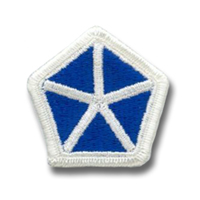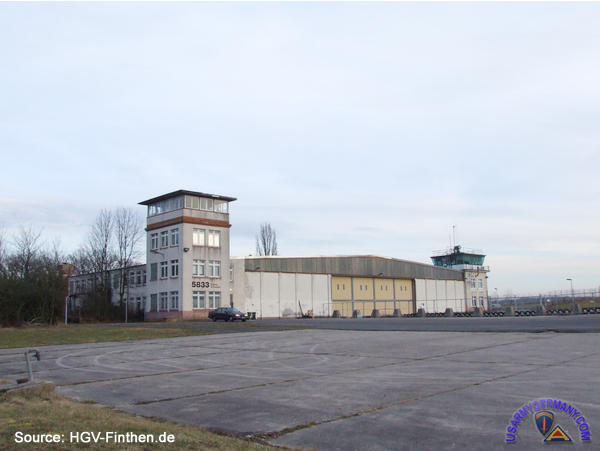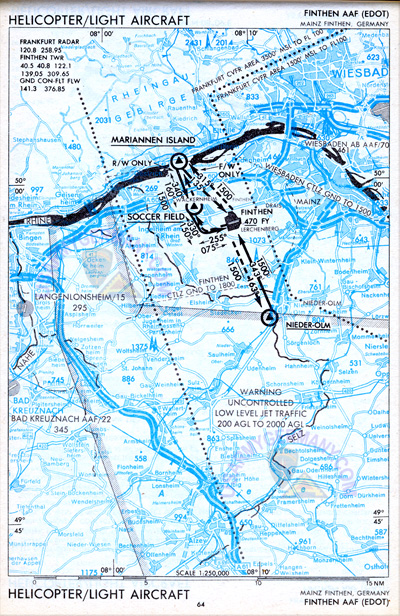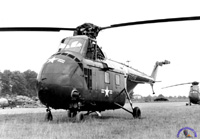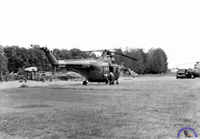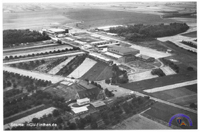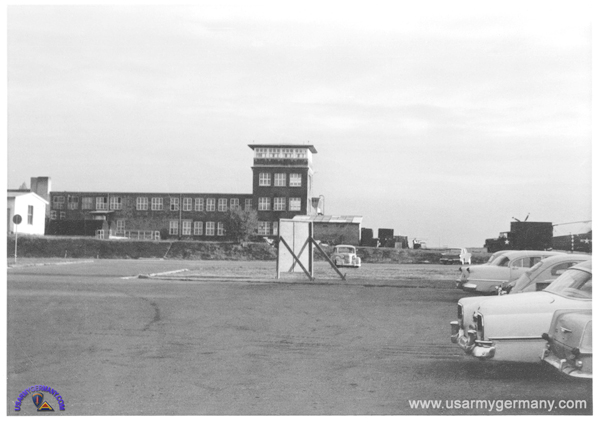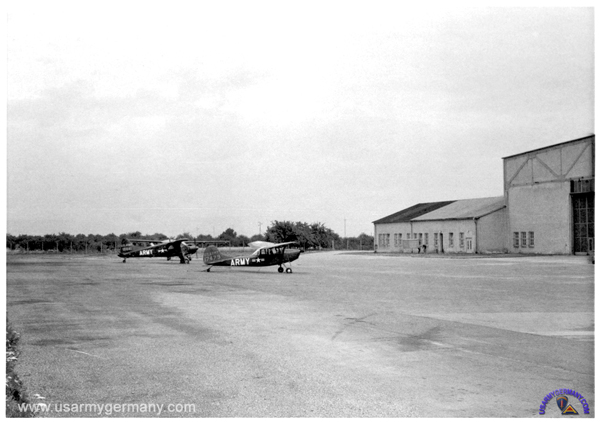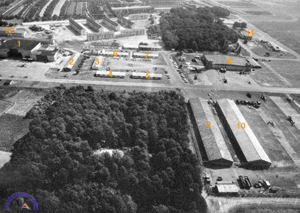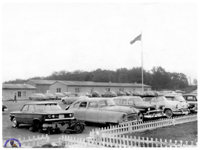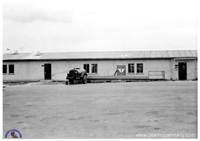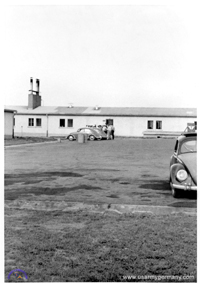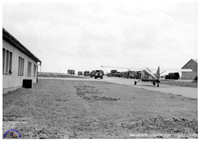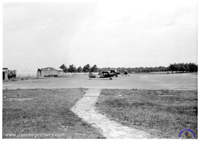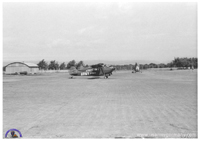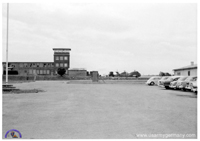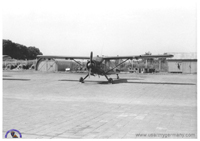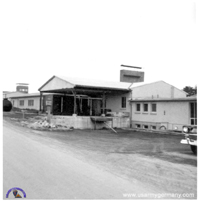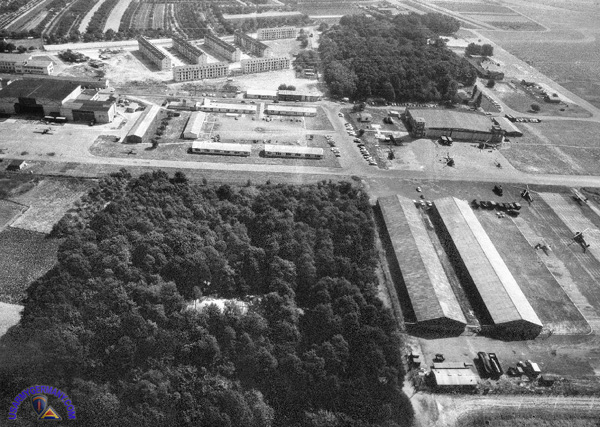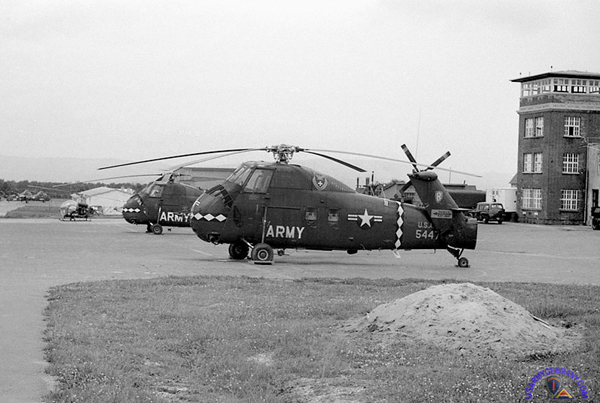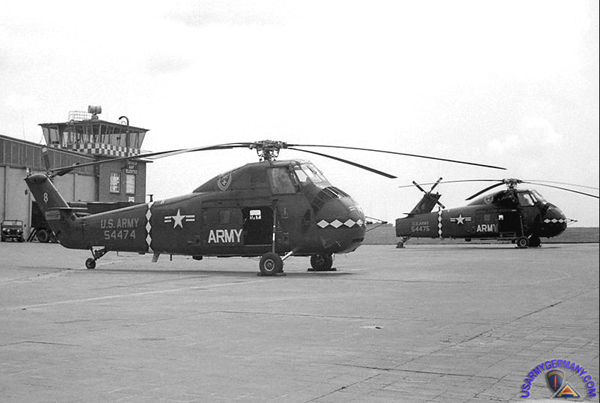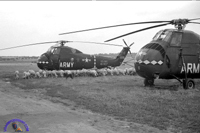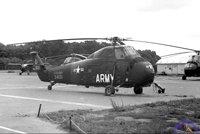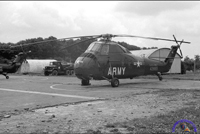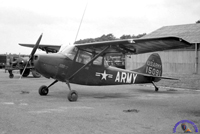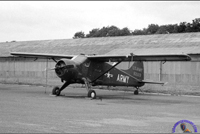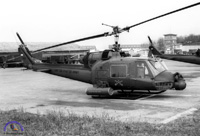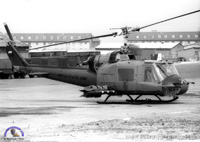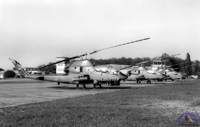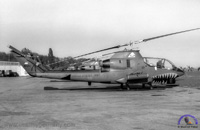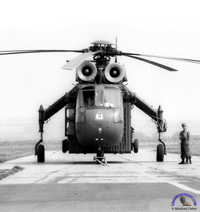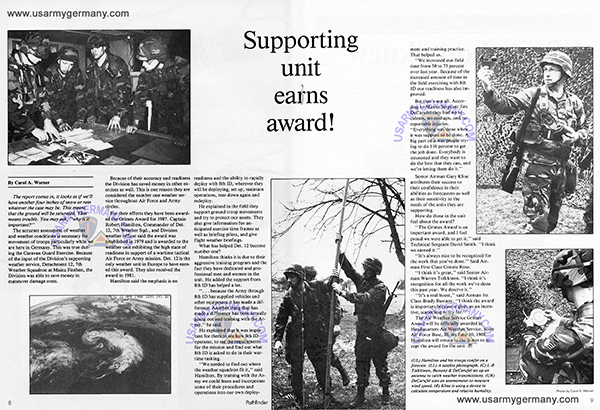| If you do
NOT see the Table of Contents frame to the left of this page, then
Click here to open 'USArmyGermany' frameset |
|||||||||||||||||
|
Finthen Army Airfield |
|||||||||||||||||
|
|
|||||||||||||||||
|
|||||||||||||||||
|
|
|||||||||||||||||
| History | |||||||||||||||||
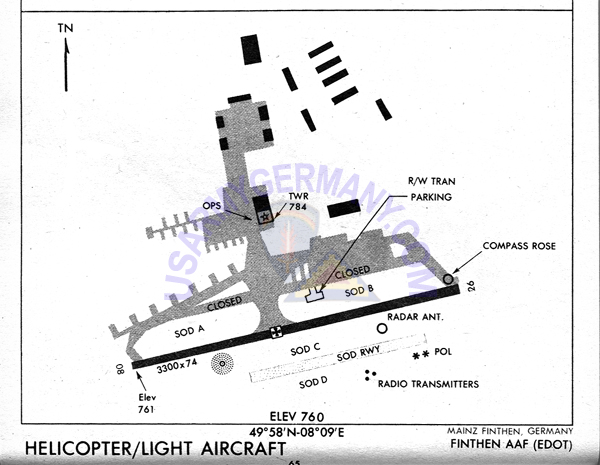 Finthen AAF airport sketch (DoD VFR Routes, 1984) |
|||||||||||||||||
| 1958 | |||||||||||||||||
| (Source: Email from Ingo Schlösser, Germany, current chairman of the History Club Finthen) | |||||||||||||||||
| On September 11, 2010 we had an exhibt about the historical farm Layenhof. In 1939 the German Luftwaffe built an airfield (Fliegerhorst) on the Layenhof-Areal. After the WWII the French Army used this airfield, which later would become the Finthen Army Airfield.
On you website I found very important information for our exhibit concerning the history of the FAAF. Now I have a question and I’m asking for your help. Attached you will find two pictures of the French airfield in Finthen (l’aérodome de Finthen). A French soldier made these pics 1958 in the south of the airfield. They called this place “Battalion americane”, because this part wasn’t part of the French airfield. It was used by the US Army. In the picture provided by Paul Mullen on your Finthen AAF Page you can see this place on the left corner upside. In the attached pictures you can see a Sikorsky helicopter (H-19). The little wood in the background is still there today. Also in the background you see the remains of the destroyed “Luftwaffe” hangars. They were later rebuilt by the US-Army on the same place und they were also used as hangars.
|
|||||||||||||||||
|
|||||||||||||||||
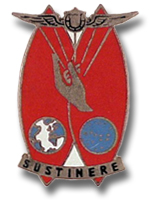 41st Transportation
Bn (AAM) DI
41st Transportation
Bn (AAM) DI |
|||||||||||||||||
| 1961 | |||||||||||||||||
| The 41st Trans Bn and the 245th Trans Co moved from Mannheim to Finthen Army Airfield in Jan 1961. Finthen was assigned at that time the mission of furnishing heavy maintenance and supply support to 7th Army. The supply side was handled by the 7th Army Transportation Depot, part of the 245th Trans Co. Its role was to furnish aircraft and surface supply support to all 7th Army units. |
|||||||||||||||||
|
|||||||||||||||||
|
|||||||||||||||||
|
|||||||||||||||||
| 1964 | |||||||||||||||||
| (Source: Photo Pages by Manfred Faber, Germany) | |||||||||||||||||
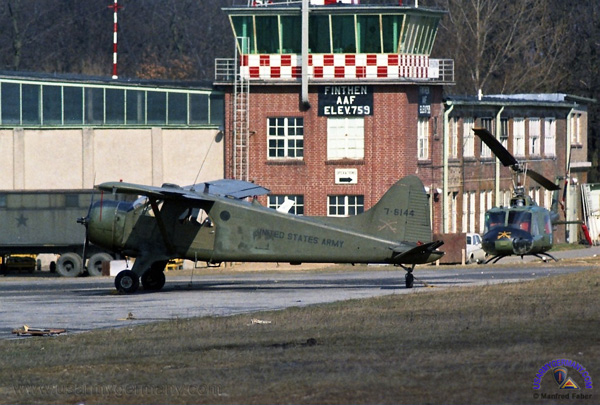 Finthen Army Airfield, 1964 |
|||||||||||||||||
| (Source: Email from Earl Cadenhead, 1964-66) | |||||||||||||||||
| I was a soldier stationed with the 8th Aviation Company, 8th Div., Finthen, Germany from Fall of 1964 to Fall of 1966. Airfield Commander was Capt. "Papa" Graham from Augusta, GA for about my first year there. Then Maj. Maxmillen took over when Papa retired. If memory serves, several family housing building were built in 1965 and Battalion headquarters moved to Finthen and we became part of Hq. Co., 8th Avn Bn. with sleeping quarters over the headquarters. I was a flight operations coordinator. I remember many a late night send off of OV-1 Mohawk spy planes into the Berlin area. |
|||||||||||||||||
| 1965 | |||||||||||||||||
| (Source: Email from Paul Mullen, Co A, 8th Avn Bn, 1965-66) | |||||||||||||||||
| (Click here for additional photos and comments of Finthen AAF and 8th Avn Bn from Paul Mullen) | |||||||||||||||||
| (Source: dogspotter62 photostream on Flickr) | |||||||||||||||||
|
|||||||||||||||||
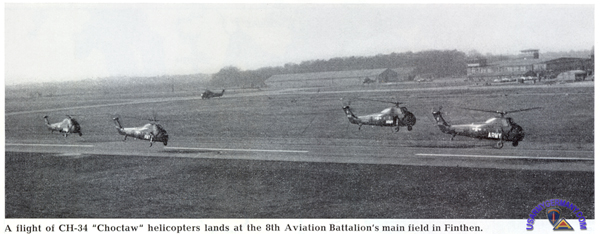 (Source: The 8th Infantry Division, 1967) |
|||||||||||||||||
| 1967 | |||||||||||||||||
| (Source: STARS & STRIPES, Feb 14, 1967) | |||||||||||||||||
| Finthen Army Airfield, the largest airfield in the 8th Infantry Division, is home to the 8th Avn Bn. The air traffic control tower is located on one end of a large operations and maintenance building alongside the airfield's one runway. Army air traffic controllers and Air Force weathermen operate inside the tower. The entire airfield is under the direction of the air controllers, no aircraft movement is made without their approval. They sit in front of a console with dozens of switches, lights and gauges. The console is also equipped with radio that allows the controllers to communicate with aircraft on the ground and in the air, as well as with other airfields. On the other side of the tower, are the weathermen. They monitor a teletype that prints out weather reports from all over Europe. They are responsible for relaying the prevailing weather conditions to the controllers and pilots. Most of the (air traffic) at Finthen consists of rotary aircraft such as the CH-34, UH-1B and OH-13. Fixed-wing aircraft at the airfield include U-1A OTTER and the (Bearcat). When weather turns bad and a plane or helicopter cannot land making a visual approach, the tower hands over landing operations to the GCA van. The van is located next to the runway directly across from the control tower. Its job is to guide an aircraft under IFR (instrument flight rules) using radar only. The pilot must fly on instruments and must rely completely on the GCA operator. |
|||||||||||||||||
| 1970 | |||||||||||||||||
| (Source: STARS & STRIPES, Jan 25, 1970) | |||||||||||||||||
| Finthen Army Airfield (FAAF) recently received a $1.5 million facelift. This is the first modernization effort at the post since the late 1950s. The airfield, USAREUR's only fully instrumented all-weather landing strip west of the Rhine River, has a population of almost 1300, including dependents, and is home to 35 fixed-wing and rotary aircraft. Commanding officer of the airfield is Lt Col James P. Owens, who also serves as the Aviation Officer for 8th Inf Div and Installation Coordinator for FAAF. The airfield is operated by the 50 enlisted men and two officers of Det C, 8th Supply & Transportation Bn. The new facilities include: This coming spring, a $250,000 project is also planned for FAAF that will see a new water and sewage processing plant constructed in the dependent housing area. 1) the new hangar was constructed in the US, shipped to Germany and put up by a local German construction firm. Before the new hangar was installed, the unit's mechanics worked out of vans and tents. |
|||||||||||||||||
| Early 1970s | |||||||||||||||||
| (Source: Photo Pages by Manfred Faber, Germany) | |||||||||||||||||
|
|||||||||||||||||
| 1977 | |||||||||||||||||
| (Source: Photo Pages by Manfred Faber, Germany) | |||||||||||||||||
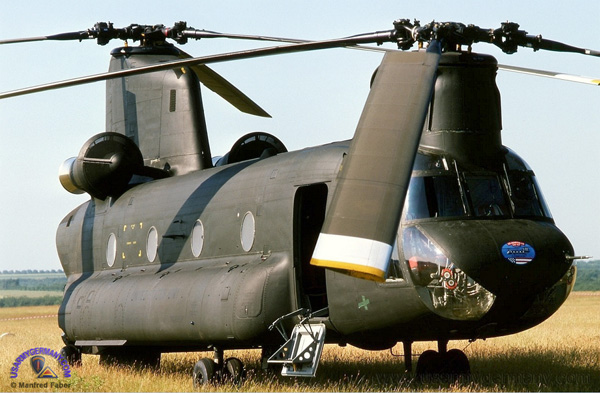 1. CH-47C at Finthen Army Airfield, 1977 |
|||||||||||||||||
| 1980s | |||||||||||||||||
| (Source: Danny Smith via Hanno Englaender, Germany) | |||||||||||||||||
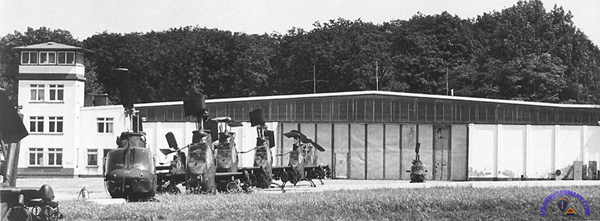 AH-1Fs & OH-58Cs of B Co, 8th CAB sit in front of Finthen's Hangar No. 1, 1980's |
|||||||||||||||||
| 1985 | |||||||||||||||||
| (Source: YouTube website) | |||||||||||||||||
 CH-47 takes off from runway 08 and flies towards Rhine River - CH-47 takes off from runway 08 and flies towards Rhine River - |
|||||||||||||||||
| Several aerial shots of the airfield at Finthen. | |||||||||||||||||
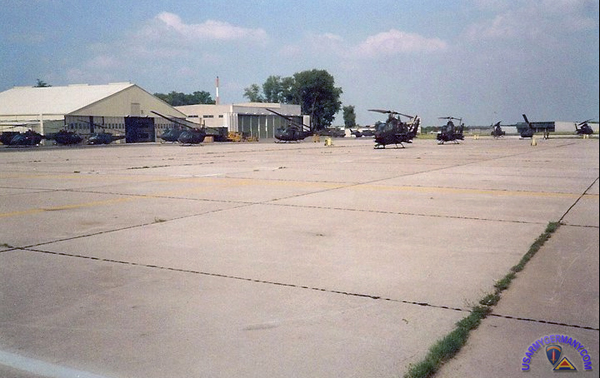 Choppers (AH-1, UH-1 & OH-58) of 3rd Bn, 4th Avn at Finthen AAF (Shawn Meze) |
|||||||||||||||||
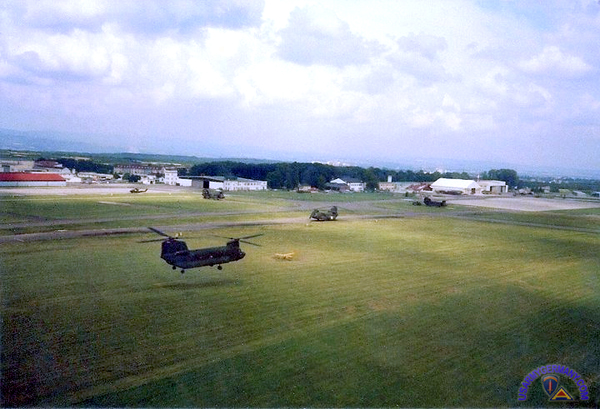 A CH-47 CHINOOK of 205th Avn Co lands at Finthen AAF (Shawn Meze) |
|||||||||||||||||
| Detachment 12, 7th Weather Squadron (USAFE) | |||||||||||||||||
| 1983 | |||||||||||||||||
| (Source: Pathfinder, January 1983) | |||||||||||||||||
| Weathermen: Air force forecasters commander's battle tool. "But this isn't the worst of the situation. Lack of visibility, continued rains, have completely grounded my airforce. My technique of battle calls for close-in, fighter-bomber support and if my planes can't fly, how can I use them as aerial artillery. "Sir, I have never been an unreasonable man. I am not going to ask you for the impossible. I don't even insist upon a miracle; for all I request is four days of clear weather. " Excerpt from Gen. George Patton's prayer for good weather during the Allied offensive into the Ardennes, Dec. 1944. MAINZ-FINTHEN, W. Ger. -- Since the beginning of armed combat, leaders have known the importance of weather in the outcome of a battle. In peace time or war, weather can often be the deciding factor in a commander's course of action. Knowing this, division commanders look for the most accurate weather forecast. In the 8th Infantry Division, those forecasts come from Detachment 12, 7th Weather Squadron. Det. 12, a unit of the U.S. Air Force Air Weather Service, provides staff and operational weather support to the Division. Part of that mission is to also provide combat weather support, according to Lt. Col. James C. St. John, air commander for Det. 12 and division staff weather officer. The Detachment is far from the only weather station in Europe. According to St. John, almost every Army division-size element in Europe has air weather service detachments, which come under the 7th WS. The 7th WS, which supports all U.S. Army Europe, comes under the 2nd Weather wing. "There are 14 detachments (under 7th WS) around Europe, from Grafenwoehr and Berlin to Italy" St. John said adding that all weather support comes strictly from the Air Force. The 16-man detachment finds that maintaining an air weather service is harder than it sounds. Part of their mission includes providing support to the 8th Combat Aviation Battalion, full service weather forecasts operational planning, severe weather warnings, staff weather reports and maintaining two-man operational weather observation teams. "Along with that we provide combat weather teams and give forecasting service for the maneuver rights area of responsibility during exercises," St. John said. The Detachment's devotion to duty has been noticed by other than the Division. They were nominated by Headquarters 7th WS as the best tactical weather unit in USAREUR. They were selected the best in the European theater by Hq. 2nd WW and will receive the 2nd W W Readiness Award for 1985. According to the airmen of the detachment, they didn't feel that had done anything special. They agreed that what they had done was their job. According to Tech. Sgt. Edgar C. Riberdy, Det. 12, forecaster, this is the second year they have won the award and with luck will go on to win the Grimes Award. All worldwide winners of the Readiness Award will compete for the Grimes award. The winners will be announced in January 1986. Criteria for evaluating the nominees includes the effectiveness of the unit in providing weather support during field exercises or actual crisis or contingencies and the impact of that support, the effectiveness of unit tactical training programs and the wartime readiness of individuals in the unit, and finally the readiness of unit tactical equipment. "Our biggest factor in winning the Readiness Award was the close support we received from the Division," St. John said. "The Division shares this award with us." According to Riberdy, though the award is based on tactical readiness, their job is much harder in the field. "There's no lead time or radar which makes severe weather reports harder," Riberdy said. He added that being tactical itself was something they had to learn. "We have to learn the things regular Army soldiers are taught, like driving five-ton trucks, setting up camouflage and taking care of our own weapons," Airman 1st Class Rory Koch, Det. 12, said. "It's two jobs in one. You have to become part of the Army." |
|||||||||||||||||
| 1988 | |||||||||||||||||
| (Source: PATHFINDER, May 1988) | |||||||||||||||||
| Related Links: | |||||||||||||||||
|
|||||||||||||||||
